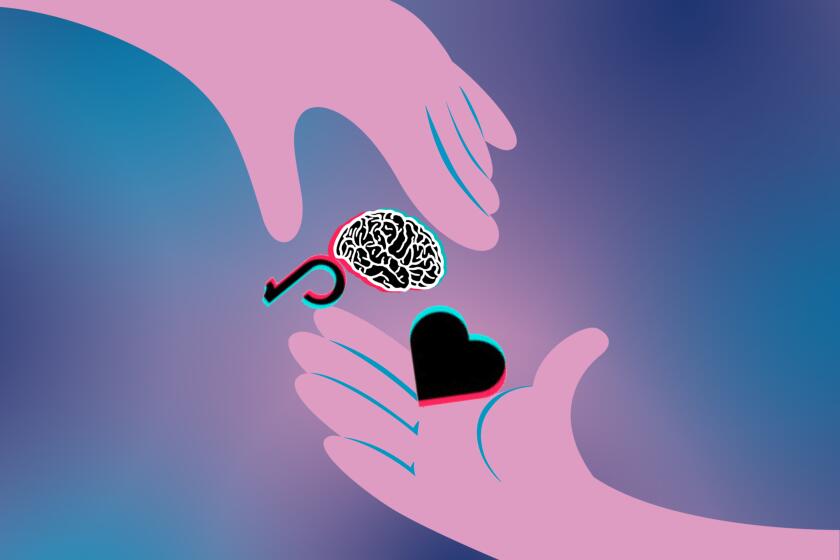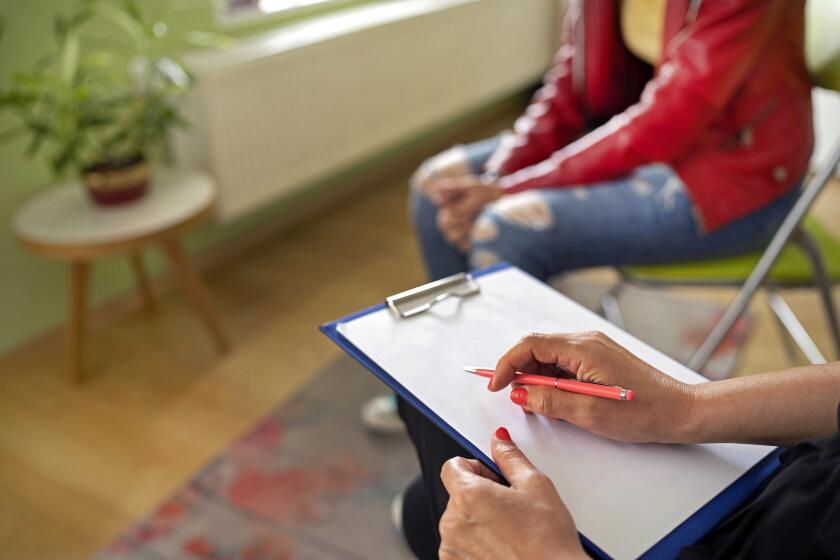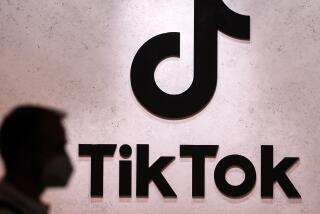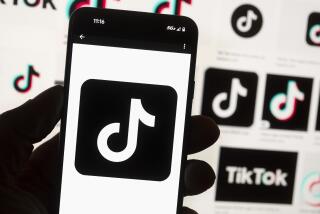TikTok is helping Gen Z with mental health. Here’s what it can and can’t do
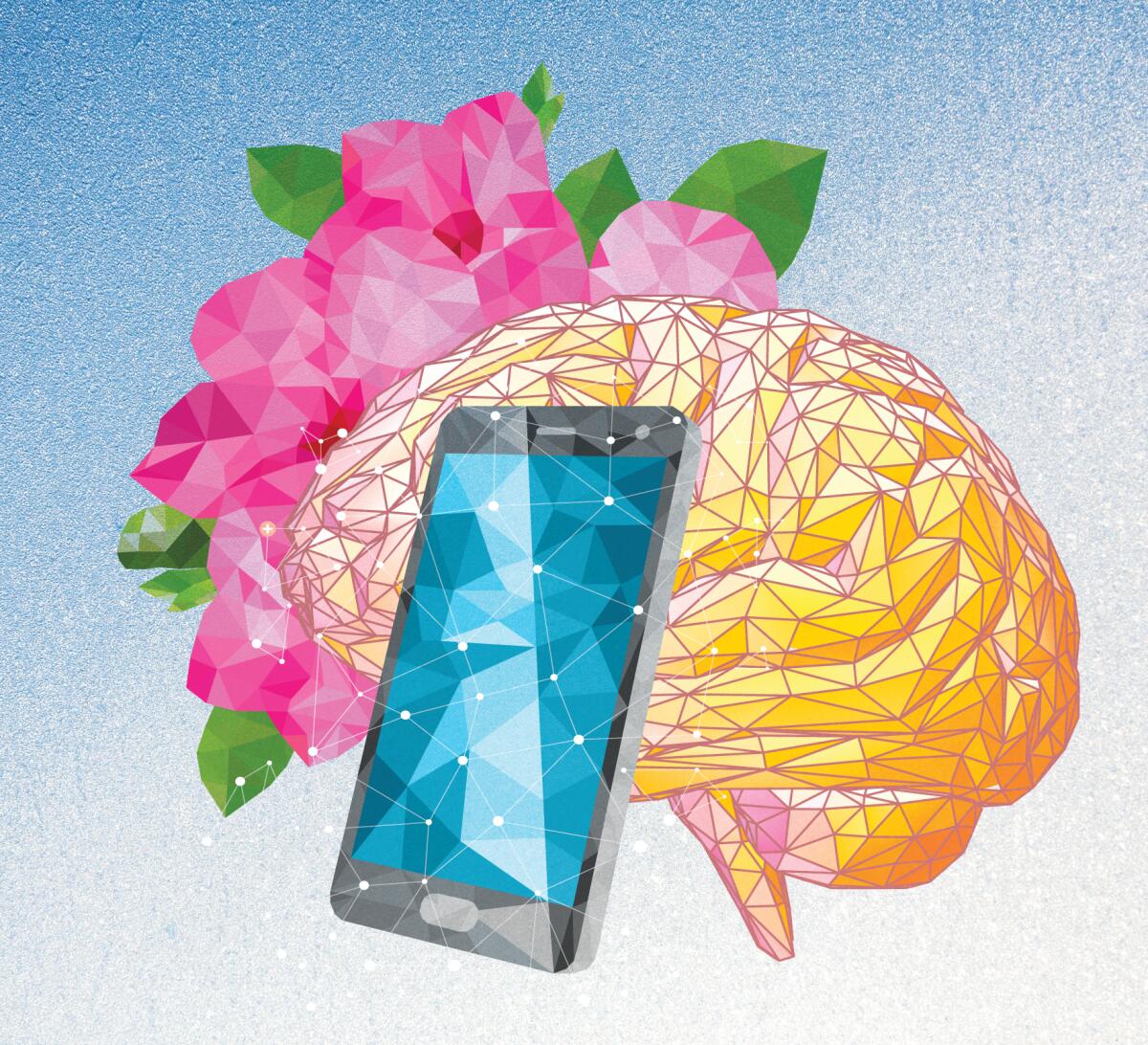
- Share via
TikTok videos with the hashtag #mentalhealth have accumulated more than 20 billion views. And that’s not counting #anxiety, which has almost 11 billion views, or #adhd, with close to 9 billion.
The short-video app may be known for trendy dances and goofy humor. But TikTok has also become a place for young people to share their mental health struggles, learn from therapists and find community with others facing similar challenges.
In early December, U.S. Surgeon General Vivek H. Murthy issued a public health advisory calling attention to adolescent mental health challenges that have been exacerbated by the pandemic. Data from the World Health Organization shows that in 2021, one in seven adolescents ages 10 to 19 struggled with mental health challenges.
That group is a key part of TikTok’s audience. Nearly half of the app’s active users are 10 to 29 years old.
Evan Lieberman, a licensed social worker known as Evan the Counselor to his more than 1 million followers on TikTok, recognizes that social media is often responsible for the dissemination of incorrect information. But he said the benefits of more people learning and talking about mental health outweigh the potential negatives.
Here’s how TikTok can help people with mental health challenges — but also what its limits and potential negative effects are and when it’s time to seek professional help.
My mom was on TikTok before I was, sharing recipes and places to buy incense. But as the pandemic changed the world — and me — the TikToks she sent changed too.
What can TikTok mental health videos do for you?
Education One of the main benefits of talking about mental health on TikTok is that users are exposed to people with different conditions, said Peter Wallerich-Neils, who’s known as Peter Hyphen to his more than 416,000 followers on TikTok, where he initially began posting to discuss his diagnosis with attention deficit hyperactivity disorder.
This helps people learn terminology, and when they find other people with their own issues, they can start a dialogue about their symptoms. But also, Wallerich-Neils said, “It’s kind of holding a mirror up to themselves and they can realize, ‘Oh, my gosh, I didn’t realize that this is something that I thought only I dealt with’ — knowing that there could be a name for it. And ‘I am part of this community that I didn’t even know existed.’”
Validation Those who may be feeling alone in their struggles often can find the validation they need, Wallerich-Neils said.
Like many others, he took to social media at the beginning of the pandemic to fill the void created by the lockdowns. On TikTok, he began to analyze and share the ways that his ADHD diagnosis affected his everyday life and found that many connected with his journey.
Community Dr. Kojo Sarfo, a mental health nurse practitioner and psychotherapist with more than 1.9 million followers on TikTok, said the app creates spaces where those with mental health conditions can feel that they belong.
This connection is especially important for communities where mental health is rarely talked about or is even considered a taboo subject.
John Piacentini, a professor in the UCLA Department of Psychiatry and Biobehavioral Sciences, said the weight of the pandemic is heavy for adolescents. Teens and young adults have an increased need for peer interaction and a higher sensitivity to social exclusion. Lockdowns, online learning and social distancing mandates have disrupted their lives.
Social media, Piacentini said, has helped to fill those gaps, and TikTok has become a new coping strategy.
As our lives become more destabilized, it’s natural for us to seek out comfort and like-minded people. For adolescents, he said, finding community and validation on the app is not only normal but necessary for their development.
What can’t TikTok mental health videos do for you?
The information isn’t always accurate. Piacentini warns that users need to be critical of the content they’re absorbing.
“TikTok is a very effective platform to communicate with, but just be aware of what’s being communicated,” he said.
Seeing a video on TikTok that you identify with can be the first step in your mental health journey, but always do more research. Consider each person’s expertise and understand whether someone is giving advice based on personal experience or from a clinician’s point of view. Sarfo said that even users like him, who are medical professionals, should be fact-checked.
It can exacerbate symptoms. Piacentini said that some patients at the UCLA Child OCD, Anxiety and Tic Disorders Clinic and Tourette Assn. Center of Excellence have been exhibiting worsened symptoms that he and other professionals believe may be a result of watching content online.
He recommends avoiding anything with negative messaging or what appears to be exaggerated symptoms. While Piacentini doesn’t believe that this type of content is being made maliciously, not everyone is a professional.
Research shows that more frequent use of TikTok and other social media can lead to negative effects. The cyberbullying, social exclusion and drama that can occur on these networks have been associated with higher rates of mental health issues in adolescents.
It’s not enough information for a self-diagnosis. No two people are the same, Lieberman said, and it’s important to figure out what you’re experiencing and not assume that you’re having the same issue as someone else.
If you start to identify with symptoms you see in videos, he recommended trying to learn coping skills to manage the individual symptoms rather than clumping them all together and adopting a diagnosis.
Our brains are wired to imitate, like how babies learn by watching adults, Piacentini said. This means that users can begin to imitate the things they’re seeing on TikTok. In some cases, this can cause people to adopt symptoms or change their behaviors to match what’s being presented on the app.
Having a basic understanding of what’s going on with you is important to your overall mental health, but try to keep an open mind, Wallerich-Neils said. Just because you’re presenting certain symptoms doesn’t mean you have that particular mental health condition.
When it comes to taking on an actual diagnosis or making any major life changes — such as medicating — consult a mental health professional.
A good place to start, Sarfo said, is with your primary care physician or pediatrician. Because mental health conditions like anxiety, depression, ADHD and burnout are so common, most general practitioners are comfortable treating and monitoring your condition. And if they aren’t, they can refer you to an appropriate specialist.
School counselors aren’t just there for scheduling or helping your kids get into college. They’re a part of a school-based mental health team that’s trained to monitor and improve students’ well-being.
When to seek professional help
While social media can provide some relief, it might be time to consult a professional if you notice sharp changes in your behavior, mood or relationships.
David W. Bond, director of behavioral health for Blue Shield of California, told The Times that if a teen has intense feelings that last more than two weeks or has the intense feelings for most of a two-week period, that’s a sign of something more serious afoot.
Getting a formal diagnosis is important, but not everybody has access to mental healthcare, Wallerich-Neils said. For adolescents, who often can’t get care without an adult’s permission, treatment can feel even further out of reach.
Minors who don’t feel comfortable talking to their parents should consider confiding in another trusted adult or a counselor at school. While there are exceptions — for example, if the student poses a danger to themselves or others — school counselors are obligated to protect confidential information received from students.
More to Read
Sign up for The Wild
We’ll help you find the best places to hike, bike and run, as well as the perfect silent spots for meditation and yoga.
You may occasionally receive promotional content from the Los Angeles Times.
